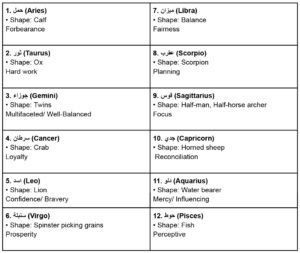Pearls of Wisdom
In the second Wa’az Mubarak, Syedna Mufaddal Saifuddin Aqa TUS highlighted the second orbit of the skies, called the The Sphere of the Fixed Stars. The Sphere of the Fixed Stars or كﻠﻔﻟا جورﺑﻟا in Arabic, is where the twelve zodiacs reside. As suggested by the name, جورﺑ, which means a tall tower, the Sphere of Fixed Stars is high and secure, so high that the closest star in this sphere is 4 light years away and the farthest star, known to mankind, is 28 billion light years away. Syedna TUS explained that depending on the position of the sun in relation to the buruj, children born at these times possess different qualities. Maula TUS proceeded to outline the wa’az mubarak, breaking the bayyan into two points: the belief one should hold of the zodiac signs and the impact of the zodiacs on one’s characteristics.
First, Maula TUS explained the belief mumineen should hold regarding the Sphere of the Fixed Stars. The number of fixed stars is immense, displaying the brilliance of Allah Ta’ala’s qudrat. Although these stars do have an effect on people’s characteristics, Syedna TUS stressed that they should not be idolised, because ultimately the power lies with Allah Ta’ala and his Awliya. In this context, Imam Mehdi Billah AS was cautioned by an astrologist that travelling was not advised at the time he intended to do so. In response, he said that he would travel under the guidance of Allah Ta’ala and that the stars and the kingdoms were for them (Awliya Allah).

Syedna TUS started with Aries, or لﻣﺣ in Arabic. One whose birth sign is Aries is disposed to being forbearing. The height of forbearance was displayed when Imam Moiz AS set out to observe nature, but was swarmed by mumineen. Instead of dismissing the mumineen, he listened to each query, with patience and grace, to such a degree that mumineen did not realize that their queries could cause frustration, but in fact felt that Imam Moiz AS had set out for their assistance. Maula TUS then alluded to the fact that parents should also raise their children with this quality of forbearance.
Maula TUS continued to explain each zodiac sign, for example he explained that people born under the sign of Leo or دﺳا in Arabic are usually brave and confident. Elucidating the height of bravery, Maula TUS narrated the well-known riwayat of Maulana Ali AS. He was on the verge of killing one of the enemies in battle, when the man spat upon him. This angered Amir-al- Mumineen. Due to the emergence of anger, he spared the man and when asked why he spared the enemy, Maulana Ali AS stated that he did not want his anger to be part of the reason for killing the enemy.
From Aries to Pisces, forbearance to perceptiveness, Maula TUS expounded each zodiac sign and its corresponding characteristic. Syedna Mufaddal Saifuddin Aqa TUS then illustrated each characteristic with Sha’anat displayed by Imam Husain AS and the shohada of Karbala.
THE INFLUENCE OF IMAM HUSAIN AS IN KARBALA:
Forbearance: When Imam Husain AS reached Karbala, the army of Yazeed began to assemble. Seeing this, some of the companions of Imam Husain AS requested him to strike first, but Imam Husain AS displayed his forbearance and replied: They are the Ummah of my grandfather: I will not initiate the battle!
Hard work: As the battle raged on Ashura and each martyr fell in battle, Imam Husain AS himself carried their bodies on his shoulders and gathered them together.
Multifaceted: When Imam Husain AS decided to end the battle, he sheathed his sword and rested against a date palm. As the enemies surrounded him, he looked at them with the eyes of Rasulullah SAW.
Loyalty: Imam Husain AS displayed his loyalty by fulfilling the promise he had made to his grandfather Rasulullah SAW to sacrifice his house and his children for the salvation of his Ummah. As well as when Maulana Abbas AS reached the furaat and filled Sakina’s mashki, he didn’t drink a single drop of water.
Bravery: When Imam Husain AS began his final battle in Karbala, he killed selectively for the ridaa of Allah.
Prosperity: Even in the trying conditions of Karbala, Imam Husain AS solemnised the nikah of his daughter Sakina and married her to his brother’s son Abdullah AS.
Fairness: Hur AS had stopped Imam Husain AS from leaving, but when he realized his sin, he bowed to Imam Husain AS and repented. Imam Husain AS forgave him and gave him raza for shahadat.
Planning: Imam Husain AS knew that the enemy would dishonour his haram after his shahadat. Thus, he told them to wear double clothing. Additionally, directed Imam Ali Zainulabedeen AS to look after the haram.
Imam Husain AS performed his last sajdah, he prayed for the mumineen to come until the day of judgement. He planned for their forgiveness and salvation.
Focus: Even in his last moments, Imam Husain AS did not lose focus. He performed sajdah and prayed for the salvation of mumineen.
Reconciliation: Imam Husain AS raised his six-month-old son and asked the enemy for a sip of water. In return he would guarantee them janat.
Mercy: The zikr of Imam Husain AS and his matam will forever guide mumineen and will improve their circumstances.
Perceptiveness: Imam Husain AS hid his grief and pain through sabr and shukr and did not waver from fulfilling his promise in Karbala.
